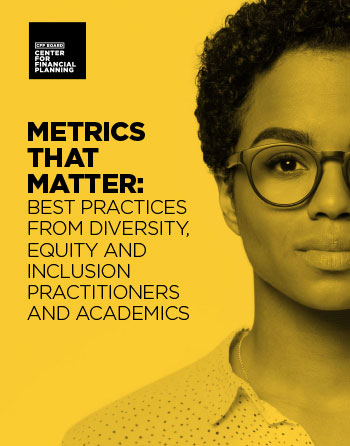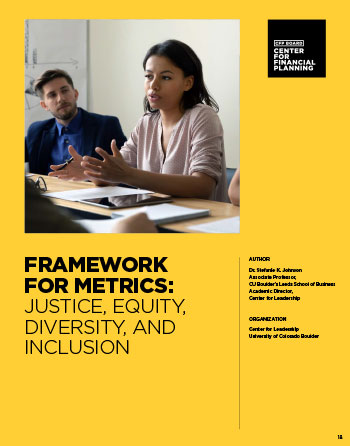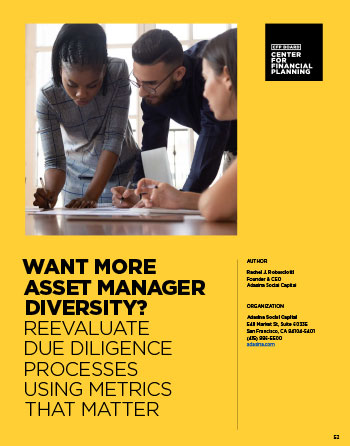Metrics that Matter: Best Practices from Diversity, Equity and Inclusion Practitioners and Academics

Metrics That Matter: Best Practices from Diversity, Equity and Inclusion Practitioners and Academics presents articles from academics and practitioners. These articles outline recommendations and lessons learned based on their research and experience with the goal of diversifying the financial planning profession. Each article addresses a different stage and component of the diversity, equity and inclusion (DEI) journey.
It is imperative that the financial planning profession works toward expanding and diversifying the identities represented in its workforce — and the workforce must change in order to meet the needs of increasingly diverse consumers. This publication therefore serves two purposes:
- To showcase how metrics can advance and measure DEI work.
- To demonstrate how research can inform the ways practitioners implement DEI work.
View the list of contributors and article summaries below
Featured Articles and Contributors:
The articles compiled in this thought leadership report each exemplify best practices, and address a different stage and component of the DEI journey.
Contributors include experts from Dartmouth College; University of Colorado, Boulder; Wealthspire Advisors; Morgan Stanley; and Adasina Social Capital.

Inclusive Leadership Metrics: The Question of Self-Awareness
Ella Bell Smith, Ph.D.
Dartmouth College
Because leaders hold such a critical role in organizations, companies, and communities, their actions and behaviors in modeling inclusion have a resounding effect on their spheres of influence to foster belonging. Inclusive leaders are driven by their self-awareness, and this article provides tools to recognize and measure this through self-reflection and identification of traits. These traits can help inclusive leaders address their blind spots and build upon their strengths to ensure that they are able to bring all their colleagues along. This article explores inclusive leadership, a relatively new approach to leadership that particularly focuses on the value of self-awareness. Indicators reveal that self-awareness is a major characteristic of inclusive leadership. The article also attempts to answer these questions: how do we measure self-awareness as it relates to DEI? How do we know a leader is self-reflective and critical about how identities impact one’s capacity to be an inclusive leader?

Framework for Metrics: Justice, Equity, Diversity, and Inclusion
Stefanie Johnson, Ph.D.
University of Colorado, Boulder
JEDI (justice, equity, diversity and inclusion) is a top priority for many companies. But as more companies do this work, it raises the question of how to measure success. What are the right metrics? This article provides a framework for companies who want to set JEDI metrics. The concept of leading and lagging indicators is used to achieve JEDI goals. A lagging indicator is a measure of the success of JEDI practices. It is easy to measure but hard to change and includes: representation (recruitment and retention); rewards, raises and reviews; return on investment (ROI); and reputation. In contrast, leading indicators can be difficult to measure but are useful in determining whether an organization is achieving its JEDI goals and includes: procedural fairness; programs and participation (including pipeline); polls and pulse surveys; and procurement. With insights from Jason Golub, Vice President of Diversity & Inclusion at Walker & Dunlop and Annette O’Hanlon, Chief Corporate Responsibility & Diversity Officer at S&P Global, this article shares real-world examples of each.

Starting a DEIB Journey: The Wealthspire Story
Crystal Cox & Laura Barry
Wealthspire Advisors
Now a leading RIA, Wealthspire was formed in May of 2019 through a combination of mergers and acquisitions of several smaller firms. Although we intentionally prioritized strength in corporate culture to foster sustainable long-term business outcomes, our efforts in the realm of diversity, equity, inclusion, and belonging (DEIB) were limited, but burgeoning. We know that we can’t improve what we can’t measure. That’s why we use our business intelligence dashboard, Microsoft PowerBI, to capture age, length of service and self-reported ethnicity and gender data on all current employees. We have been tracking the data only since our inception in May of 2019, but we can point to some small steps forward in those two years. In addition to tracking the progress we’ve already made, we wanted to be able to identify and measure efforts we can make today that will result in a more diverse workforce tomorrow. That’s why we also expanded our metrics platform to include diversity data for new hires, employee retention, pay equity, and promotion data. We feel that by tracking these leading indicators, we can go beyond snapshot measures to generate actionable insight that will allow us to pursue our goal of creating a work environment that is truly more equitable. As we’ve been looking at the world — and ourselves — through a DEIB lens, we’ve begun to notice how small efforts can make a big difference. We know that we are still in the early stages of this journey. Unraveling hundreds of years of white privilege that has been woven into the fabric of our business and into the larger society is going to take a lot of time and effort. We have many challenges ahead, but we’re committed to the hard work — and to learning a lot along the way.

DEI Signal: Assessing Managers on Diversity, Equity and Inclusion
Lisa Shalett, Emily G. Thomas, Adriane Parris, Steve Edwards, Emily M. Feczko
Morgan Stanley
Evidence demonstrating the importance of DEI in the workforce is growing. Companies are increasingly evaluating their cultures and practices related to gender and racial equality in order to attract and retain top talent, and investors are increasingly asking for this data to be disclosed while seeking to invest with asset managers who are making progress on improving diversity. These changes are not just important from a cultural and social perspective; rather, they can be interlinked with financial outcomes. In keeping with our endeavor to promote transparency and accountability in the investment management industry, we have developed DEI Signal to monitor asset managers’ progress and potential in achieving more diverse and balanced representation across their key decision-makers.

Want More Asset Manager Diversity? Reevaluate Due Diligence Processes Using Metrics that Matter
Rachel J. Robasciotti
Adasina Social Capital
The current rise in focus on DEI has propelled a number of financial services firms and institutions to launch their own strategies and policies to increase DEI. However, those who would benefit most are often excluded from the conversations that determine what these strategies are and what makes them effective. To build effective and sustainable strategies for strengthening DEI, companies must ensure that they consider both quantitative and qualitative metrics that benefit the communities they intend to impact. In financial services, these communities are often represented by diverse Asset Managers, owned and operated by women and people of color. This article proposes an important shift in focus for financial planning firms that wish to increase DEI in financial services, based on the author’s consultation with diverse Asset Managers. Financial planners can meaningfully advance DEI by focusing not only on increasing diversity of their own staffing, but also by using systems that increase diverse perspectives throughout the financial services industry.

